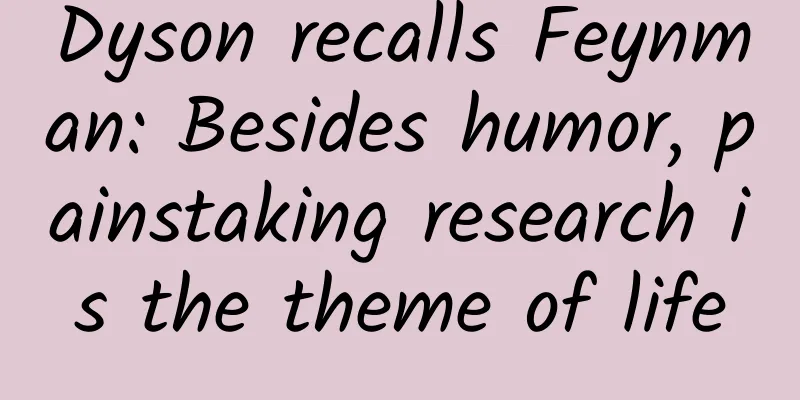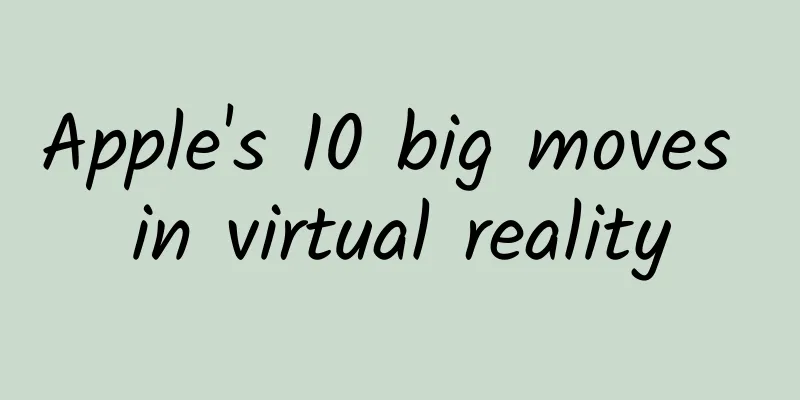Dyson recalls Feynman: Besides humor, painstaking research is the theme of life

|
The legendary physicist Feynman is always associated with the word "genius", not only because of his academic achievements, but also because of his "performance", always finding the joy of discovery in jokes. In the view of Feynman's close friend Freeman Dyson, the "clown" who is always on the stage is Feynman's life choice, but it is not his main theme. In the world of physics, Feynman is a conservative. His achievements that have stood the test of time and benefited every physicist were built brick by brick in long, slow and hard work. This is the core theme of his scientific career. Written by Freeman Dyson Translation | Li Pan Photo credit: Shelley Gazin/Corbis This is a wonderful collection of Dick Feynman’s adventures, all true. I heard Dick’s voice and saw him gesticulating as I read them. All of Feynman’s friends owe a debt to Ralph Leighton, who saved these stories on tape and printed them in book form. My favorite story is “Stop It, Mr. Feynman!”, about Dick’s first formal tea party at Princeton University. When the hostess asked him if he wanted cream or lemon with his tea, his answer was “I want both.” This answer revealed the core of Dick’s character: he would take anything, cream or lemon, comedy or tragedy. That’s why he had so many crazy adventures and lived such a creative life. Feynman knew the pain of chronic illness and the pain of early death, but he knew, like Shakespeare, that in every tragedy there is a comic moment, when the tragic hero steps aside and gives his place on the stage to the clown. To stay awake when tragedy strikes, as Feynman did, being a clown helps. Even in his most serious moments, when he was wrestling with the infinite self-energy of electrons at Cornell, or digging for the cause of the space shuttle Challenger tragedy in Florida, or even in Albuquerque with his dying young wife, Arlene, he was not a serious man. In this preface, I want to write mainly about Feynman's penchant for hard work. From the stories that Feynman and others tell about him, one can easily get the impression that Feynman spent most of his time being silly or having amusing adventures, interrupting this carefree life only occasionally to focus on scientific research and make outstanding scientific discoveries. This impression is not entirely wrong, but it misses the most important part of his character. The central theme of his life was long, slow, hard work, and his whole energy was spent on painstakingly poring over scientific problems until they were solved. The adventures and jokes were real, but they were not the main theme. The stories are somewhat misleading because Feynman's contribution to science is a paradoxical dissonance between style and substance. His scientific style is brilliant and impressive. He described nature with easy-to-understand diagrams rather than obscure differential equations, and he used dramatic gestures and sound effects to support his lectures rather than blackboards covered with difficult symbols. But the essence of his scientific research was conservative. He arrived at his insights not through brilliant creation but through a careful sifting of old theories and experiments. He was not a revolutionary. He preserved old theories as much as possible, stretching them to accommodate new experiments. He built his new theories brick by brick on the old ones. Nothing he built was hastily done, and all his results have stood the test of time. As he often said, when some revolutionary new ideas were proposed, it was more important that they were correct than that they were brilliant. Whether he was reconstructing the foundations of physics or interpreting the results of a new experiment, he spared no effort to ensure that the details were correct. The scientist's task, he said, was to listen carefully to nature, not to tell nature how to act. Feynman had two highly creative periods in his life as a physicist. The first lasted 10 years, from 1939 to 1949, from Princeton to Cornell, with a stint at Los Alamos. The second, also 10 years, from 1960 to 1970, was at Caltech. At Princeton-Cornell, he reconstructed his theory of atoms and radiation and the interactions between them. At Caltech, he reconstructed his theory of the nuclear force and strongly interacting particles. In both periods, he integrated many puzzling experimental results and used them to build a coherent picture of how nature works. He relied as little as possible on existing theories and as much as possible on experimental facts. He built up his theoretical picture piece by piece, like a puzzle of mathematical pieces; he tried hundreds of different combinations until he found the right one. He also spent years struggling to find possible answers, only to find that they were contradictory or wrong. When I was a student at Cornell, watching Feynman work reminded me of what the economist John Maynard Keynes had said about Isaac Newton. Keynes, who collected and studied Newton’s manuscripts, wrote: “Newton’s unique gift was his ability to hold a purely intellectual problem in his mind until he saw through it to its core. I think his excellence was in the strongest and most persistent power of intuition that ever existed.” This description of Newton could be applied to Feynman just as well, and it describes exactly how he worked. He kept the problem of calculating the interaction between radiating atoms in the context of Einstein’s theory of relativity in his mind for ten years, and he didn’t give up until he found the answer. I had the privilege of meeting him in his tenth year of struggling to find the answer to the atoms and radiation problem, and in this last year, the puzzle pieces finally began to fall into place. But I watched him struggle through this last year, still getting stuck in the mathematical mire or into a physical dead end, and I was more frustrated than excited. Revelation does not come in a flash of genius, but slowly, in the dawn of understanding, after a long night of hard work. While at Caltech, Feynman similarly tackled a much more complex problem: fitting strongly interacting nucleons into a coherent picture. The problem was more complex because there were a dizzying number of particle and interaction types. Feynman solved half of the problem. He developed a theory that observable particles were made up of a set of smaller fundamental components he called “partons.” Using the behavior of relatively simple parton components as a guide, he found rules for calculating the behavior of observable particles. His rules explained the experimental results, but left many details to be worked out later. As this work progressed, he kept exchanging ideas with younger Caltech colleagues Murray Gell-Mann and George Zweig. Gell-Mann and Zweig had each developed their own theories, which were similar to Feynman’s, but their descriptions of partons were more specific. Gell-Mann called his partons “quarks,” while Zweig called them “aces.” Today, more than 50 years later, only quarks are remembered, and partons and aces have been forgotten. Gell-Mann's nuclear quark model became the standard model in teaching and accepted by everyone. Feynman has always given generous praise to Gell-Mann and Zweig's discovery, believing that their theory surpassed his own. Because of this discovery, Feynman personally recommended them to the Nobel Prize Committee in 1977. If he won the prize, it would be Gell-Mann's second Nobel Prize, but the Nobel Prize Committee did not accept Feynman's recommendation. Feynman’s greatness as a scientist did not depend on any particular discovery. His greatness was that he created a language that is now used by physicists all over the world. Today, everyone takes his “spacetime method” and diagrams for granted when describing how nature works. The core of the spacetime method is to take literally what the ancient Greek philosopher Heraclitus said: “Everything flows.” According to the spacetime method, nature flows from an initial state to any final state through all possible histories simultaneously. Each possible history has an amplitude, and the amplitude has a magnitude and a phase. To calculate the probability of reaching a final state, you just need to add up the amplitudes of all the histories that preceded it and calculate the square of the sum of the amplitudes. By adding up the contributions of the set of diagrams that describe each history, you get the amplitude corresponding to that history. This way of describing nature through “sums over histories” is one of the great unifying principles in the history of science. In addition to his decade of elucidating the foundations of atomic and nuclear physics, Feynman also studied a variety of other problems. He was interested in almost everything and dared to plunge into unfamiliar fields. He spent a year doing virus experiments in the biology department of Caltech. At the end of that year, he discovered some interesting facts about viral gene mutations, but he still judged that he was not cut out to be a biologist, so he returned to the physics community with renewed enthusiasm. At that time, biology was all about experiments without theories, and the inability to establish theories was something Feynman could not tolerate. After returning to the field of physics, he made what he considered to be the most beautiful discovery: a new natural law that describes how a particle called neutrino interacts with matter. In any branch of science, if someone found a mystery, Feynman would dive in. In the 1950s, the most tantalizing mystery was in the field of low-temperature physics. In 1938, Soviet physicist Peter Kapitsa discovered that liquid helium becomes a superfluid at temperatures close to absolute zero. Fifteen years after Kapitsa's discovery, the explanation of superfluids remained a famous unsolved mystery. Superfluidity is a strange state of matter. Once a superfluid material is in motion, it will keep flowing and never slow down. Feynman took up the challenge and built a theory of superfluidity based on the sum-of-histories method of calculation. He showed that the superfluid state is a natural result of the sum of the histories of the liquid, provided that you have to consider that all the helium atoms are exactly the same. Because helium atoms are exactly the same, you have to add up all the histories, including the results of all possible ways that atoms can be interchanged and arranged. Feynman showed in a simple way that the movement of the liquid will cause it to form a vortex that will continue to rotate forever unless there is any external interference. This theory explained why liquids are superfluid. After Feynman established this theory, Caltech used new experiments to verify it in detail, and the results confirmed that the theory was correct. Feynman’s theory of physical reality, the “sum over histories,” had both philosophical depth and practical usefulness. It gave us a quick and easy way to calculate what would happen, but it also provided a deep insight into why our common-sense notions of matter and motion are misleading. Feynman knew that nature worked, as Arthur C. Clarke put it, not just stranger than we think, but stranger than we can imagine. The sum over histories theory gave us a vivid, intuitive experience of nature’s strangeness. But Feynman was always a calculator first, and a philosopher second. The most important thing for him was getting all the details right. Like his theory of the sum of physical realities, Feynman's insights into human nature are both philosophically profound and practically useful. Some of his stories are as profound as his physics research. In this preface, I have emphasized the scientific side of Feynman and have said little about his human side. I did this because the vast majority of this book is about his human side. If you want to understand Feynman's human side, I recommend reading the essay on the life of his first wife, Arlene. This story is dictated by Feynman himself and is titled "Why Do You Care What Other People Think?" in the collection. This is the longest essay in the book and the most difficult story for Feynman to tell. His spirit always shines with her soul. This article is authorized to be excerpted from the preface of "Classic Feynman: The Adventurous Life of a Curious Man". Special Tips 1. Go to the "Featured Column" at the bottom of the menu of the "Fanpu" WeChat public account to read a series of popular science articles on different topics. 2. Fanpu provides a function to search articles by month. Follow the official account and reply with the four-digit year + month, such as "1903", to get the article index for March 2019, and so on. Copyright statement: Personal forwarding is welcome. Any form of media or organization is not allowed to reprint or excerpt without authorization. For reprint authorization, please contact the backstage of the "Fanpu" WeChat public account. |
<<: Confessions of a Fall Armyworm
>>: Do peanuts promote cancer metastasis? I advise you to eat them this way to be safe!
Recommend
What is the best JavaScript framework for mobile and desktop applications in 2021?
This article is reproduced from the public accoun...
How to use the points system to stimulate user retention (Part 1): Classification and definition of points
The so-called points system is based on points. B...
Ammonia treatment administrator: Why can this battery save fish lives?
Author: Duan Yuechu Ammonia is a toxic compound t...
My Primary Growth Map
The Internet has developed to this stage, and the...
Mathematics courses for programmers strengthen basic development skills and use mathematical principles to optimize code
Programmers' mathematics class consolidates b...
Practical video course production, promotion, and money-making video course with a monthly income of over 10,000 yuan
Free software and files Speaker: Xie Yinlong 0 ba...
8 steps and 5 stages to build a private community SOP from 0 to 1
There is more and more consensus on doing private...
How to achieve accurate traffic diversion from 0 to 1?
“You will never make money beyond your perception...
Stock, increment and retention in product operation
In the process of product operation , data or tec...
China Automobile Dealers Association: Regional market analysis of new energy passenger vehicles in March 2022
According to the China Passenger Car Association&...
APP promotion: How to seize the free channel resources of the app store
CPs! Let’s talk about the app store The group lea...
I frequently get acne around my nose, and some people even say I have kidney deficiency?
Anyone who has had acne knows that there are many...
Instead of gushing out lava, they spit out mud. How much do you know about Xinjiang's mud volcanoes?
Your browser does not support the video tag The l...
The new Kia K5 has a younger look: the name "Diaosi Sanbao" is not in vain
It is said that the three treasures of losers are...
7 Tips to Optimize Your Amazon PPC Ads
There are a lot of suggestions on optimizing Amaz...









